#bone marrow edema
Explore tagged Tumblr posts
Text
Standing on tiptoes: an action that has been passed down for 800 years. Do it seven times a day for one minute to replenish kidney qi, treat back pain, and prevent stroke (Figure 2)
Another reason is that the subcutaneous fat layer of the feet is thin, and if you pull up the epidermis, there is almost nothing but bones underneath, so it is easier for external pathogens such as wind, cold, and dampness to invade the body.
The blood supply is slightly insufficient compared to the legs and arms, so cold evil can easily invade here and gradually accumulate, spreading upward and inward to other parts of the body.
Only by warming up and protecting your feet can the cold evil have difficulty invading the body.
Standing on tiptoes: an action that has been passed down for 800 years. Do it seven times a day for one minute to replenish kidney qi, treat back pain, and prevent stroke (Figure 3)
The Book of Changes says: "To repeat its course every seven days is the way of Heaven. " The Records of the Grand Historian records: "The number of yang is seven. " This is the natural rhythm of the movement of celestial bodies and yin and yang.
The reason why the feet need to be shaken seven times in the saying “Shake the back seven times to get rid of all diseases” is probably a reflection of the cultural connotation of the infinite reciprocating and rhythm of life represented by the number “seven”.
Five benefits of regular foot shaking
1. Antidepressant
Depression is caused by the inability of Yang Qi to reach the brain to nourish the brain marrow, resulting in poor circulation of Qi and blood in the brain and the blocking of the clear orifices by turbid Yin.
Tapping the heels can simultaneously stimulate the bladder meridian and the three yin meridians of the foot, including the kidney meridian, spleen meridian, and liver meridian. The yin and yang energy of the three yin meridians of the foot are sufficient, which can promote the flow of yang energy upwards, allowing more qi and blood to reach the head and face.
2. Replenish kidney qi
People with weak kidney qi and insufficient kidney yang often have symptoms such as fear of cold, cold and painful heels, and edema of the lower limbs. Shaking the heels can supplement the kidney qi and promote its function of promoting yang qi, and the effect is obvious.
3. Treat low back pain
Due to the invasion of wind, cold and dampness into the bladder meridian, the circulation of qi and blood is not smooth, and pain occurs when the circulation is blocked.
Therefore, the heel-tapping method, which can stimulate the bladder meridian, can also prevent and treat low back pain, cervical spondylosis, occipital headache, etc.
4. Prevent stroke
Traditional Chinese medicine believes that all strokes are symptoms of yin-excess and yang-deficiency caused by the decline of true yang, and cerebral hemorrhage is a symptom of yang rushing upward due to "yin-excess and yang-deficiency".
Stimulating the heels of the feet can not only stimulate the circulation of qi and blood in the brain, but also lead the floating yang downward through the bladder meridian and kidney meridian to the soles of the feet.
5. Treat urinary problems
In Western medicine, difficulty in urination is a prostate disease, which is often seen in prostate hypertrophy, prostatitis, etc. From the perspective of traditional Chinese medicine, it is caused by unfavorable bladder gasification.
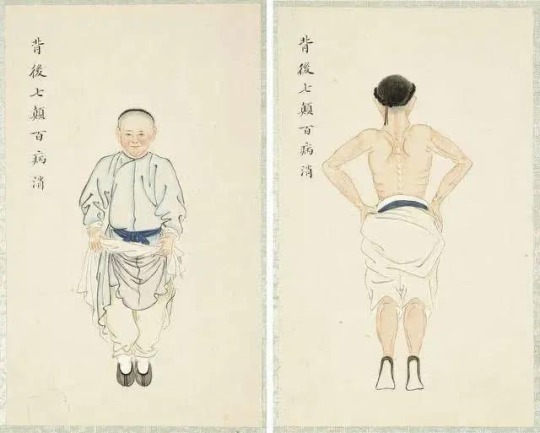
Stimulating the heels is a little trick to treat prostate disease.
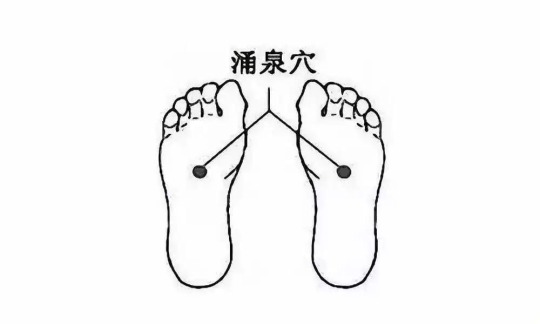
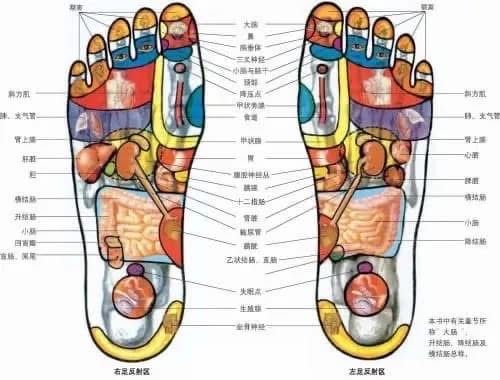
14 notes
·
View notes
Text
Reference saved in our archive
This study demonstrated a significant increase in the prevalence of bone marrow edema of the phalanges after the onset of the COVID-19 pandemic, particularly in middle-aged and younger women.
Must be that anxiety
#mask up#public health#wear a mask#wear a respirator#still coviding#pandemic#covid#covid 19#sars cov 2#coronavirus
6 notes
·
View notes
Text
So guys. I have an extra bone in my ankle that apparently only 10 to 15% of the world's population has. Well it's pinched in my muscles and causing bone marrow edema, what ever that means. But next week is my follow-up for this mornings MRI. Let's hope they don't need to remove the bone and it'll unpinch its self 🤞🤞
Cause that would mean I could get back in the gym!!
2 notes
·
View notes
Text
“Marina Roe” (France, ~1993)
Death in sickle cell patients after abortion has been documented for decades, but in one especially tragic case, a single abortion that was supposedly “therapeutic” instead ended four lives.
“Marina” was a sickle cell patient who was pregnant in the second trimester with triplets. The report of her death does not specify the exact age of her babies, but countless premature babies delivered in the second trimester have survived when given medical attention. Even if they had been too young to survive, guaranteeing their deaths in utero would have offered no medical benefit— especially since a second-trimester abortion would take much longer than delivery.
The abortion was carried out using prostaglandin E2 instillation. A few hours later, Marina was already showing signs that something was going very wrong. She was suffering from bone and joint pain, and her hemoglobin was only 8 gm/dL. (For reference, 12 gm/dL is considered severely low in most women.) She was given 4 units of blood, but developed trouble breathing and deteriorated so badly over the next four days that she was admitted to the ICU.
By the time she was admitted to the ICU, Marina had trouble breathing and was suffering from confusion. Her chest x-ray showed pulmonary edema. Despite intensive treatment, she became even worse. Doctors put her on a ventilator and performed a heart catheterization. Based on her test results, they suspected an embolism. An exchange blood transfusion of 30 mL was initiated. Despite all attempts, Marina suffered respiratory failure and died the next day of acute right heart failure.
Marina’s postmortem exam found “marked pulmonary vascular congestion with focal alveolar hemorrhage and edema.” In addition, the diagnosis of embolism was confirmed by “massive amounts of fat in lung capillaries typical of fat embolism.” The cause of death was diagnosed as “massive fat embolism resulting from bone marrow necrosis.”
After Marina’s death, her case was analyzed. Several points were noted when the actions taken contributed to her death, including notes on how some should have been handled differently.
First, Marina was more predisposed to bone marrow fat emboli to begin with because of her sickle cell disease. Abortion is very well-documented as a cause for pulmonary emboli even in healthy people, so this should have been carefully considered.
Second, it was noted that “Massive transfusion without blood exchange… could have favored bone marrow necrosis and fat emboli by increasing blood viscosity.” Doctors reviewing her case also referenced that PGE2 (the chemical used in Marina’s abortion) also acts as a vasodilator, increasing blood flow on top of the already increased viscosity.
Marina was also given an insufficient exchange transfusion in her last days of life. She was given 30 mL of blood when the medical journal reviewing her case stated that life-threatening situations require at least double that amount. It was also theorized that “the severity of pulmonary involvement in our patient when exchange blood transfusion was performed may also have contributed to the failure of the treatment.” Marina’s treatment was, quite literally, too little too late.
Sherika Mayo, Betty Gail Hines, Margaret Davis, Barbara Riley, “Vera Roe” and “Jenny Roe” are a few other sickle cell patients killed by deadly side effects of their legal abortions, which were all too frequently recommended to them under the suggestion that it would be healthier for them. Women with sickle cell disease (and their children) deserve better.
https://doi.org/10.1002/ajh.2830430431
#unsafe yet legal#tw abortion#tw negligence#women deserve better than abortion#abortion is not healthcare#pro life#tw ab*rtion#tw murder#abortion#abortion debate#death from legal abortion#unidentified victim
3 notes
·
View notes
Text
Cancer: The Astroherbology Profile

Alexis J. Cunningfolk
It's time to explore the sign of Cancer!
I will be exploring all twelve signs from a medical astrology perspective with an emphasis on herbal healing. Learn more about the series and what all the correspondences mean check out the introduction to The Introduction to Astroherbology Zodiac Series. Missed the other signs of the Zodiac? Find out about the astroherbology wisdom of Aries, Taurus, and Gemini!

Element: Water Mode: Cardinal Guardian Planet: Moon Direction: South Season: Summer (NH), Winter (SH) House: 4th House / Angular Lunar Mansions: 7th, 8th, and 9th Mansions Solar Gemstone: Rose Quartz Tarot: The Chariot, The High Priestess, 2 of Cups (6/21 - 7/1), 3 of Cups (7/2 - 7/11), 4 of Cups (7/12 -21), Queen of Cups Tissue State: Damp/Stagnation, Cold/Depression (learn more about the energetic system of traditional western herbalism)
Body Systems: The Chest, Breasts, Stomach, Uterus, Ovaries, Diaphragm. Bone Marrow. Pituitary Gland and hormones. Upper Alimentary System. Brain covering. Ribs, Sternum, and Elbow joint. Lungs. Serum of Blood. Thoracic Duct. Peristaltic pump. Pleura and Pleural Cavity. Bladder. Protective coverings of the organs including the Pericardium and Meningeal coverings.
Imbalances + Diseases: Digestive diseases and indigestion including gas and bloating, ulcers, Crohns disease, and diseases of the gall bladder. Fluids in the joints. Asthma with excess fluids. Tuberculosis, consumption, and wet coughs. Infectious lung diseases. Sinus infections. Lack of or overproduction of fluids in the body, including excess mucus, edema, water retention, and fluids in the lungs. Swollen gums and soft teeth. Cysts in the breasts and breast diseases. Breastfeeding complications including mastitis. Bone marrow disease. Ovarian imbalance and diseases including infertility. Peristaltic dysfunction. Bladder infections. Abscesses. Lack of vitality. Shortness of breath. Indigestion, including diarrhea, gas, heartburn, and leaky gut. Excess mucus of the digestive tract. Pituitary imbalance, including lack or excess production of oxytocin and ADH. Lack of or excess saliva. Nausea. Poor relationship with food including overindulgence in food or lack of eating, including eating disorders such as anorexia and bulimia. Depression and emotional stagnation. Lack of drive, including physical drive whether for fitness or sexual intimacy. Lack of bodily tone. Unwanted excess weight. Fixating on the past and not present circumstances. Self-isolating and highly defensive. Oversensitivity to other’s emotions and the environment in general can lead to paranoia. Inappropriate and harmful relationships full of emotional coercion, closing off from the world, apathy, giving but not receiving, issues of trust and faith in others.
Disease Degrees: 0 degrees: drowning, eyesight; 1 degree: sixth rib, eyesight, drowning; 2 degrees: seventh rib; 3 degrees: eighth rib, eyesight; 4 degrees: ninth rib; 5 degrees: tenth to twelfth ribs, sleep and trance; 6 degrees: diaphragm, sleep and trance; 7 degrees: thoracic cavity; 8 degrees: esophageal opening of the diaphragm, paralysis; 9 degrees: pylorus, azimene; 10 degrees: fundus of stomach, azimene, alcoholism; 11 degrees: gastric veins, azimene, chronic glomerulonephritis, alcoholism; 12 degrees: greater curvature of the stomach, azimene, alcoholism; 13 degrees: lesser curvature of the stomach, azimene. 14 degrees: stomach walls, azimene, blindness or defective sight; 15 degrees: gastric nerves, azimene, blindness or defective sight; 16 degrees: Pancreas; 17 - 18 degrees: duodenal opening of pancreatic duct, chemicals, poisons, gas; 19 degrees: Ampulla of bile duct, bile, chemicals, poisons, gas; 20 degrees: Superior pancreaticoduodenal artery; 21 degrees: inferior pancreaticoduodenal artery; 22 degrees: gastric mucosa, weak or impaired vision; 23 degrees: gastric blood vessels, weak or impaired vision; 24 - 25 degrees: blood vessels of digestive organs, danger through water, gas, poisons, dog bites; 26 degrees: mammary glands; 27 degrees: nipples, digestive troubles; 28 degrees: cartilage of ribs, hair, digestive troubles, depression mental and emotional difficulties and instability, spleen; 29 degrees: spleen, bronchitis, depression mental and emotional difficulties and instability; 30 degrees: twelfth thoracic vertebra, bronchitis.
Remedies for Imbalanced and/or Weakened Cancer: Learning to trust. Choosing healthy relationships with emotional give-and-take. Taking time for periods of retreat, but not isolation. Becoming self-soothing. Warming and drying herbs. Dry skin brushing. Lymphatic tonics and cleansers. Diuretics. Mineral rich herbs and supplements for grounding.
Gifts of Cancer: Emotional depth and intelligence. Ancestral heritage and wisdom. Security and developing a nourishing home environment. Intuition and psychic gifts. Empathy.
Rituals of Cancer: Trance and journeywork. Psychic development. Past Life work. Visionary dreaming. Fertility rituals. Self-empowerment.
Cancer Guardian Herbs: Aloe Vera (Aloe barbadensis), Chamomile (Matricaria recutita), Burdock Root (Arctium lappa), Red Clover (Trifolium pratense), Fenugreek (Feoniculum vulgare), Chickweed (Stellaria media)
Cancer Remedy Herbs: Agrimony (Agrimonia eupatoria), Chamomile (Matricaria recutita), Angelica (Angelica archangelica), Dandelion (Taraxacum officinalis), Cleavers (Galium aparine), Yellow Dock Root (Rumex crispus), Rosemary (Rosmarinus officinalis), Ginger (Zingiber officinale)
Flower + Gem Essences: Clematis, Agrimony, Red Chestnut, Honeysuckle, Chamomile, Moonstone
The Sun in Cancer
I think that one of the quickest ways to understand Cancer is to take a look at the sign’s zodiac symbol, the crab. The crab is a liminal animal, straddling both land and sea. Cancers are creatures of the water, but they dwell mostly on the shore. Their strength lies in their emotional experiences of the world. It is through their emotional sensitivity that they perceive the world and they place a lot of self-worth in their ability to be sensitive. We live in a world that does not value sensitivity - being sensitive is dangerously subversive because it requires us to be aware of the way we are impacting the lives of others including the life of our beautiful ocean planet. Another aspect of the crab to pay attention to is that it carries it home with it everywhere and has a hardy, defensive exterior with a soft interior. Being sensitive requires the ability to retreat and recuperate because deep feeling all the time can be overwhelming. Carrying their homes with them, Cancer folk are also often concerned about home life in general and creating homely, welcoming, and nurturing spaces.
While the sensitivity of Cancer and their ability to move between the world of the physical and the emotional with ease can be a great gift, it can also be one of Cancer’s greatest struggles. Their sensitivity can become overwhelming and they can retreat from the world of large, becoming apathetic, depressed, defensive or some combination thereof. If they haven’t invested enough time in or valued the importance of emotional intelligence, they can find themselves in inappropriate relationships that can be codependent, draining, and emotionally coercive. All of this can dampen Cancer’s ability to trust and have faith in the goodness of others. They risk shifting from a liminal creature of wisdom to something a bit more crabby. Sometimes, Cancer folk can get caught up in past emotional experiences, placing priority on those memories and that version of reality rather than the current reality of the present. Yet, when Cancer folks are dwelling in their power, they have an incredible gift to journey into the past, return, and teach us about healing our ancestral heritage and tapping into a lineage of wisdom.
Within the context of medical astrology, Cancer folk are typically not the most inherently energetic of the signs of the zodiac. They have to pay close attention to how they expend their energy, but with care they can do well. Time for retreat and relaxation is important. Since they are a sign that is very lunar-oriented, spending some time in the sun (especially in the early morning) is good for recharging their energetic centers, but should not be overdone. They should also give themselves space to be quiet and creative under the light of their guardian planet, the Moon. A consciously consumed diet is important and being aware of the relationship between feelings and eating is one of their keys to longevity. While exercise is not the favorite activity of many Cancer folk, like everyone, the crab needs to move their body. Swimming, gentle yoga, and breathing exercises will all be beneficial. The gifts of Cancer folk are manifold and include the ability to connect with parts of our emotional landscape we thought we would never find again. They help us find the shore and that is such a gift as we remember to return home to ourselves again and again.
Cancer Guardian Herbs
Aloe Vera (Aloe barbadensis)
The form of Aloe Vera is reminiscent of the energetics that Cancer embodies - a hard, spiky exterior filled with soft, liquid wisdom. The inner gel of the plant is cooling and moist, alleviating inflammation in the body both internally and externally. The gel of the plant’s inner lining can be drunk daily as a nutritive and immune-building remedy. Excellent for burns, Aloe is also good for emotional, mental, and spiritual burn-out that is so common during these times of great change. The regenerative quality of Aloe means that it helps us to form new tissue cells, which is why the plant is useful in the treatment of scars. Aloe is moistening not only topically but internally as well assisting with hydration and re-hydration after exertion or prolonged sun exposure. The plant is also useful for moistening dried out bowels, improving digestion, and general vitality.
Aloe is used topically for a variety of conditions including sunburn, burns, bedsores, athlete’s foot, bruises, wrinkles, ulcers, herpes, abrasions, ringworm, shingles, dandruff, insect bites, eczema, psoriasis, hemorrhoids, and the itch of chicken pox. Deeply nourishing, Aloe helps us to relax and be present in the moment to what we need now which is a primary gift of Cancer folk.
Want access to more information on a variety of healing herbs for Cancer folk including a full medicinal and magickal profile on Aloe Vera? Join the Lunar Apothecary!
Cancer Remedy Herbs

Chamomile (Matricaria recutita)
Chamomile is both a Guardian and Remedy herb of Cancer. It is an herb with an affinity for the stomach, which Cancer guards. Chamomile is also an herb for emotional upsets that manifest in the stomach and digestive tract. Think about the person (maybe you!) who gets a nervous or upset stomach during emotionally challenging times - Chamomile is a fantastic ally. The herb is bitter and sweet which helps us to produce fluids such as bile for digestion, but also helps us to digest our emotions properly. Do you see how Chamomile is both an herb of Guardianship and Remedy for Cancer?
Chamomile is an herb forcolic-y children and young ones who have great emotional sensitivity that can make moving through the world difficult. Yet, because it is also an herb of Cancer, it has the ability for all of us at any age to connect with our inner kid, which is an exceptional quality when it comes to emotional healing. Many of us are carrying around emotional baggage from our young and formative years that can keep us floundering or stagnating in our present life. Chamomile can help us to process these difficult emotions, by gently reconnecting us with who we were before so that we can move on to who we are becoming.
Sun in Cancer Flower Essence
Since Cancer is so deeply situated within the realm of the emotions I could easily list out a hundred essences I could recommend for Cancer Sunfolk. I have chosen to go with Agrimony, alsoknown as the remedy for the tortured smile. Agrimony is for folks who are experiencing a storm of emotions inside but maintain a cheerful exterior at all costs - hence the tortured smiling. Cancer folk can sometimes fall into this pattern when they don’t feel like they have a safe space to express their emotions and have them be valued. Sometimes, Cancer folk can get so caught up in hiding their emotions from others that they successfully hide what they are feeling from themselves. Such emotional hiding suppression can lead to all sorts of discomfort and imbalance in their lives. I think Agrimony essence is also useful for those folks coping with post-traumatic stress disorder as it is very good at helping us to connect with what we are feeling deep within as opposed to connecting solely to how we are reacting in the moment. Agrimony assists us in expressing our true emotions and through that actually cultivating an authentically cheerful disposition.
Ready to learn more?
Check out the rest of my Astroherbology series including Starry-Hearted + Wild-Rooted: An Introduction to Astroherbology which includes additional study resources and the other posts in my Astroherbology series.
Need a visual guide? Starmaps: The Astrological Body is for you!
Explore The Lunar Apothecary - a full length course using the tools of moon-centered herbalism and ritual to help you discover who you are as a healer.

2 notes
·
View notes
Text
Aren't the feet-shaped-shoes-with-toes super bad for your feet? Like, lost a lawsuit to their customer base because they gave lots of people foot injuries level bad? I swear I saw something about that...
I did! I knew I didn't imagine it!
From the study "...Posttraining MRI scores showed that more subjects in the Vibram group (10 of 19) showed increases in bone marrow edema in at least one bone after 10 wk of running than that in the control group."
The toe shoes increased injuries to people's feet within the test group!
Now a lot of toe shoe users claim this happens because people swap to toe shoes too quickly and/or the shoes make them think they're suddenly good at running so they don't train properly. But those claims haven't been tested. The one that has, doesn't look good for the pro-toe-shoe side. Sorry.
Whatever shoes you put on your feet, please pay attention to your body and do not injure yourself. If something hurts, take it seriously.
guy: it sucks that the train back is such a long ride
his friend who is trying to get him to wear foot shaped shoes with toes but is taking it slow: it does
#text convos#took the joke post seriously#and on a tangent#but seriously#those shoes aren't all their cracked up to be#be careful with them#out and about#running
21K notes
·
View notes
Text
Knee preservation procedures Bangalore
Bone pain but normal X-ray? It could be bone marrow edema. Early detection = early protection.
0 notes
Text
Ouch
In addition to the severe osteoarthritis that I have, I also have chondromalacia, and have written about the damage that I did to the cartilage behind my knee. I also have bone marrow edema in my femur. I’m in a ton of pain and need to connect with my neighbor–she offered–who is a Physical Therapist. That’s not the main topic. It does hurt like a MF though. I don’t think that I mentioned that…

View On WordPress
0 notes
Text
Other things that are on the docket today to get done are that we have several individuals who are insanely annoying and they express it every few minutes and they sound like they're women and they don't control themselves on top of having cancer most of them do and they have huge flippant mouths and have not done anything for years except blue stuff and I used to doing that on the edge you were abusing people on their way down and they get abused and they start going back up again and it's a cycle that they depend on it is a cycle that the Mac proper have stated they're going to cut short this cycle completely and they are telling them and they are ignoring it just as they are ignoring the high level cancer that they have. Most of them are around a level four the two Trump and his brother have level five stage five everyone else's stage 4 multiple levels and for some reason they act like they don't know even though his brother said it out loud last night if his bone marrow as an end amount that's really edema or less it is liquefied and it is due to cancer the cells are no longer holding himself together because they are interwoven with cancerous cells and the collapsed and it's in about 50% of his finger bones and they'll be hollow fairly soon and we'll break it easily. So John c pulls up and tumbles his his bottle and purpose in a sport Wrangler green late model or dark green so he's requesting you put out an order on the idiot.
--and it will be done and we are going to make sure that he pays for it and the canisters are not empty so again he's issuing a threat and he is supposedly the supply guy.
Thor Freya
Olympus
0 notes
Text
Imaging Techniques in Musculoskeletal Radiology: A Guide to Common Conditions and Effective Strategies
Musculoskeletal radiology is a specialized branch of medical imaging focused on diagnosing and managing disorders related to bones, joints, and soft tissues. It plays a crucial role in identifying various conditions, from fractures to complex diseases like arthritis. Understanding the common conditions in this field and the imaging strategies used can help practitioners and patients navigate treatment options more effectively.
Common Conditions in Musculoskeletal Radiology
Musculoskeletal radiology encompasses a wide range of conditions, many of which are common across different patient populations. One of the most frequently encountered issues is fractures. Whether due to trauma, stress, or underlying bone conditions, fractures require precise imaging to determine the extent of injury and plan appropriate treatment. Radiographs, or X-rays, are typically the first imaging modality used, providing clear visualization of bone structures.
Another common condition is osteoarthritis, a degenerative joint disease that affects millions of people worldwide. This condition is characterized by cartilage breakdown and bone structure changes, leading to pain and reduced mobility. Imaging is vital in diagnosing osteoarthritis, with X-rays being the most commonly used method. X-rays can show joint space narrowing, subchondral sclerosis, and osteophyte formation, which are hallmark signs of the disease.
Advanced Imaging Techniques for Soft Tissue Disorders
While X-rays are invaluable for assessing bone-related conditions, they are often insufficient for diagnosing soft tissue disorders. Advanced imaging techniques like magnetic resonance imaging (MRI) and Ultrasound are commonly used in these cases. MRI is particularly effective in visualizing soft tissues, such as muscles, tendons, and ligaments. It provides detailed images that help in diagnosing conditions like rotator cuff tears, ligament injuries, and muscle strains.
Ultrasound is another powerful tool in musculoskeletal radiology, especially for real-time evaluation of soft tissue conditions. It is often used to assess tendon and muscle injuries, bursitis, and nerve entrapments. Ultrasound is also helpful in guiding therapeutic injections, making it a versatile imaging modality in clinical practice. The dynamic nature of Ultrasound allows for the assessment of structures in motion, which can be particularly useful in diagnosing conditions that are position-dependent.
Role of Imaging in Diagnosing Inflammatory Conditions
Inflammatory conditions, such as rheumatoid arthritis and ankylosing spondylitis, are other critical areas where musculoskeletal radiology plays a significant role. Early and accurate diagnosis is essential for managing these chronic conditions, and imaging is a cornerstone. MRI and Ultrasound are often used to detect early signs of inflammation in joints and surrounding tissues. MRI is particularly useful for identifying synovitis, bone marrow edema, and erosions indicative of rheumatoid arthritis.
Ultrasound can also be used to detect inflammation, especially in peripheral joints. It is highly sensitive in identifying synovial thickening and increased blood flow, which are early markers of inflammatory arthritis. The ability to assess these conditions early in their course allows for timely intervention, which can prevent joint damage and improve long-term outcomes for patients.
Imaging Strategies for Tumors and Infections
Musculoskeletal radiology is also crucial in detecting and evaluating tumors and infections. Whether benign or malignant, bone tumors require detailed imaging for accurate diagnosis and staging. X-rays are often the first step, revealing abnormalities in bone structure that may suggest a tumor. However, advanced imaging techniques like MRI and Computed Tomography (CT) are necessary for further evaluation. MRI is particularly useful for assessing the extent of tumor invasion into surrounding soft tissues, while CT provides detailed images of bone architecture.
Infections of the musculoskeletal system, such as osteomyelitis, also require precise imaging for diagnosis and management. X-rays may show early signs of bone infection, but MRI is the preferred method due to its ability to detect early bone marrow changes. MRI can reveal the extent of the disease and help guide treatment decisions, such as the need for surgical intervention. In cases where an abscess is suspected, Ultrasound can guide aspiration and drainage, providing diagnostic and therapeutic benefits.
The Future of Musculoskeletal Imaging
Musculoskeletal radiology is continually evolving, with new imaging techniques and technologies that promise to enhance diagnostic accuracy and patient care. One such advancement is Dual-Energy CT (DECT), which can differentiate between various tissue types based on their chemical composition. This technology is particularly useful in assessing gout, as it can detect urate crystals in joints and soft tissues without requiring invasive procedures.
Artificial intelligence (AI) is also making its way into musculoskeletal imaging, offering the potential to improve the efficiency and accuracy of image interpretation. AI algorithms can assist radiologists in identifying patterns and anomalies that may be missed by the human eye, leading to earlier diagnosis and better treatment outcomes. As these technologies continue to develop, they promise to transform musculoskeletal radiology, making it even more effective in diagnosing and managing a wide range of conditions.
Musculoskeletal radiology is a dynamic and essential field in diagnosing and managing various conditions affecting bones, joints, and soft tissues. From fractures and degenerative diseases to tumors and infections, imaging techniques like X-rays, MRI, and Ultrasound are invaluable tools that guide clinical decision-making and patient care. As technology continues to advance, the future of musculoskeletal radiology looks promising, with innovations that will enhance the ability to diagnose conditions more accurately and treat them more effectively.
0 notes
Text
Management of Preeclampsia

Preeclampsia is a hypertensive disorder of pregnancy, emerging typically after the 20th week of gestation. It is distinguished by elevated blood pressure and potential multisystem involvement, most frequently affecting renal and hepatic functions. This condition presents significant risks for maternal and fetal morbidity and mortality, necessitating keen monitoring, timely diagnosis, and appropriate management to ensure favorable outcomes for both mother and child.
Diagnostic Criteria and Processes
Clinical Criteria: The diagnosis of preeclampsia is confirmed when hypertension develops after 20 weeks of gestation in a previously normotensive woman, accompanied by one or more of the following indicators of organ dysfunction:
Proteinuria: Detection of protein in the urine, suggestive of renal impairment.
Renal Impairment: Other clinical indicators of compromised kidney function, such as increased serum creatinine.
Thrombocytopenia: A platelet count less than 100,000/microliter, indicative of platelet consumption or bone marrow suppression.
Hepatic Dysfunction: Elevated liver transaminases twice the normal concentration, reflecting hepatic injury.
Pulmonary Edema: Accumulation of fluid in the lungs, presenting as shortness of breath and hypoxemia.
Neurological Symptoms: New-onset, persistent headaches unresponsive to analgesics, or visual disturbances such as scotomata or blurred vision.
Blood Pressure Measurement: Blood pressure assessment in pregnancy involves measuring both systolic and diastolic pressures:
Systolic Pressure: A reading of 140 mm Hg or higher.
Diastolic Pressure: A reading of 90 mm Hg or higher.
For diagnostic confirmation, a second elevated reading taken at least four hours after the initial measurement is recommended.
Additional Diagnostic Tests: Upon suspicion of preeclampsia, a comprehensive evaluation is warranted, including:
Blood Tests: To assess liver enzymes, kidney function, and platelet count.
Urine Analysis: Either a 24-hour urine collection or a spot urine protein-to-creatinine ratio to evaluate protein excretion and renal function.
Fetal Ultrasound: Regular monitoring of fetal growth and amniotic fluid volume to assess intrauterine conditions.
Nonstress Test and Biophysical Profile: To evaluate fetal well-being through heart rate monitoring and ultrasound assessment of fetal movements, muscle tone, breathing, and amniotic fluid volume.
Management Strategies
Primary Management: The primary goal in managing preeclampsia is to balance prolonging the pregnancy to allow for fetal maturation with the risks posed to maternal and fetal health. This often involves a combination of close monitoring and medical interventions to control blood pressure and prevent complications.
Management of Mild Preeclampsia:
Outpatient Monitoring: Regular prenatal visits to monitor blood pressure, symptoms, and fetal health.
Home Monitoring: Daily self-monitoring of blood pressure and symptom tracking to detect any signs of disease progression.
Management of Severe Preeclampsia:
Hospitalization: For intensive monitoring of maternal and fetal well-being. This includes frequent blood pressure checks, laboratory tests, and fetal monitoring.
Pharmacotherapy:
Antihypertensive Medications: Such as labetalol, nifedipine, or methyldopa to control blood pressure.
Anticonvulsants: Magnesium sulfate is the drug of choice to prevent eclamptic seizures.
Corticosteroids: Administered to enhance fetal lung maturity if preterm delivery is anticipated.
Timing and Method of Delivery:
Delivery Timing: The timing of delivery is critical and depends on the severity of the condition, gestational age, and the health of both mother and fetus.
Mild Preeclampsia: Delivery is generally recommended after 37 weeks of gestation.
Severe Preeclampsia: May necessitate delivery before 37 weeks to prevent serious maternal and fetal complications.
2. Method of Delivery: Decided based on clinical factors, with vaginal delivery preferred if conditions allow. However, a cesarean section may be necessary for severe cases or if labor induction fails.
Postpartum Care
Monitoring and Follow-Up: Postpartum monitoring is crucial as preeclampsia can persist or even develop after delivery, known as postpartum preeclampsia. This involves:
Close Monitoring: Regular assessment of blood pressure and symptoms in the immediate postpartum period.
Patient Education: Informing patients about the signs and symptoms of postpartum preeclampsia, such as severe headaches, visual changes, epigastric pain, and nausea or vomiting, and advising them on when to seek urgent medical care.
Long-Term Follow-Up: Regular follow-up visits to monitor blood pressure and assess for potential long-term cardiovascular and renal implications of preeclampsia.
As academic students and researchers navigate the challenges of their assignments and research endeavors, Expert Academic Assignment Help stands ready to provide professional guidance and assistance. Whether you require support with assignment writing, research paper assistance, or essay help, our team of experts is dedicated to helping you achieve academic excellence. Reach out to us today at [email protected] and let us support you on your academic journey. We wish you success and professional excellence.
#assignment help#medical students#healthcare#nursing school#nursing student#medicine#medical help#university student#medical university#university life#university#studying#student life#study blog#study inspiration#studyblr community#studyblr#student#study motivation#medical student#case study#studyspo#study aesthetic#study notes#dissertation help#dissertation writing#dissertation abstract#dissertation topics#phdjourney#phd student
0 notes
Text
Heart Treatment in India
Treatment for the heart focuses on reducing excess fluid volume and edema and boosting the heart's pumping ability. The immediate goals include preventing progressive failure or in the worst case, sudden death. The aggressiveness in therapy is proportionate to levels of heart failure. As a common point, the emphasis is on making life easy for the left ventricle. More interventions come in to improve blood flow to the heart and increase salt and water excretion. In more aggressive stages, it goes till changing heart value and in extreme cases, a heart transplant. Best Doctors for Heart treatment in India make it a hassle-free experience.
Best Heart Hospitals in India
As of recently, India has evolved as a global favorite destination for medical tourism. Firstly, medical technology has progressed rapidly in the Indian subcontinent. Secondly, the low cost of living and medical charges makes India, a global darling.
Max Super Specialty Hospital is located in the capital city of India. To be more precise, you need to get to Saket, New Delhi. The hospital is famous for ortho, heart treatment, cancer treatment, and liver/kidney transplants.
The best hospital for Heart treatment in India is the ASEAN Heart Institute in the city of Bombay. Established in 2002, heart surgeries cost as little as a lakh and go up to 8 lakh rupees. With 250 ICU beds and over a dozen operation theatres, it prides over a solid infrastructure.
Another best Heart hospital in India is also located in Mumbai - Jaslok Hospital. Located close to Mumbai Central Railway Station, the accessibility to the hospital is good. OPD consultation fees start as low as 600 Indian rupees and a doctor's visit costs 1000 rupees here.
Best Heart Surgeons in India
Best cardiologists in India are not very hard to find, given its reputation for being medical tourism's global hub.
Ramakanta Panda:
The best heart surgeon is undoubtedly Ramakanta Panda. He works at ASEAN hospital, in Mumbai, where he also serves as its Vice-Chairman and trailblazer for media.
Dr. Devi Prasad Shetty:
Shetty serves as Chairman and Director of Narayana Hospital. Devoting his life to the field of medicine in south India, he has made a reputation for Indian doctors worldwide. His records include 35,000 heart surgeries and counting.
Dr. Yugal K Mushra
Dr. Yugal K Mushra is a Ph.D, who commands immense respect in the field of medicine. He specializes in the least invasive heart surgery through the instrumental use of robotics technology. His records boast over 500 heart surgeries with the aid of robotics and over 19,000 bypass surgeries.
My Med Trip is a top medical tourism company. We are offering complete medical and healthcare services with medical consulting in India for patients from all over the world including African countries like Kenya, Ethiopia, Uganda, Nigeria, South Africa, etc. We help you in finding the best hospitals, doctors, and good accommodations at affordable costs in India. We offer surgeries, treatment and transplant. Some of the are kidney transplant cost, heart transplant, bone marrow transplant cost, cancer treatment, liver transplant cost, prostate cancer, best cardiologist in India, ovarian cancer, hip replacement, knee replacement, shoulder replacement surgery cost, brain tumor, breast cancer surgery cost, orthopedic surgery cost in India, shoulder surgeons,orthopedic surgeons, heart valve replacement, knee surgeons, best Kidney transplant hospital in India and so on.
Source: https://mymedtrips.blogspot.com/2023/10/heart-treatment-in-india.html
1 note
·
View note
Text
The Role of R3 Stem Cell Therapy in Sports Medicine - Dr. David Greene Arizona

Sports medicine is a specialist discipline that aims to prevent, diagnose, and treat injuries caused by physical exercise and sports. Professional and unprofessional athletes always seek cutting-edge therapies to help them heal quickly and return to their best.
This groundbreaking therapy has the potential to completely transform the field of sports medicine by providing efficient remedies for a range of sports-related injuries.
In this blog, we will examine the use of stem cell therapy in sports medicine, discussing its advantages and uses and Dr. David Greene's Arizona contributions to developing this innovative therapy.
Advantages - Stem Cell Therapy in Sports Medicine
Stem cell therapy is becoming an attractive option for athletes with its various advantages -
Accelerated Healing
First, these stem cells speed up the healing process, recover fast, and return to activities for athletes soon.
Reduce Inflammation and Pain
Stem cell therapy can reduce inflammation and pain, which benefits athletes suffering from chronic injuries or conditions like arthritis.
Minimally Invasive
In contrast to surgical methods, stem cell therapy involves minimum invasiveness. Injections are used in place of incisions during the procedure, which causes less physical trauma and speeds up recovery.
Lower Risk of Complications
Because stem cells are frequently taken from the patient's body, problems and rejection are less likely. This unique method improves the treatment's efficacy and safety.
Stem Cell Therapy - Treat Common Sports Injuries
Stem cell therapy treats various sports-related injuries due to its effectiveness and versatility -
Joint Injuries
Athletes are more likely to get injuries to their joints, especially the knees, shoulders, and elbows. Stem cell therapy can repair inflammation and damaged cartilage, relieving osteoarthritis and irritation.
Muscle Injuries
Sports injuries, such as muscle rips and strains, are common. Stem cell therapy encourages muscle fiber regeneration, facilitating a speedier and more thorough recovery.
Ligament and Tendon Injuries
Stability and mobility depend on tendons and ligaments. These structures can sustain crippling injuries, such as ACL tears or Achilles tendinitis. These tissues are renewed with stem cell therapy, returning strength and function.
Bone Fractures
Additionally, stem cells can help repair bone fractures. Because stem cells encourage bone repair, they can improve fracture outcomes and expedite healing.
Step-By-Step Process of Stem Cell Therapy in Sports Medicine
If patients and athletes better understand the stem cell therapy procedure, they may feel more at ease and knowledgeable about the treatment.
Discussion and Evaluation
The first step in sports medicine through stem cell therapy is consultation with a sports medicine specialist. This entails assessing the damage, reviewing the patient's medical background, and deciding if stem cell therapy is suitable.
Harvesting Stem Cells
If it is decided to proceed with stem cell treatment, the next stage is to collect the stem cells. Usually, a minimally invasive technique like liposuction to remove fatty tissue or bone marrow aspiration is used.
Handling the Stem Cells
After being collected, the stem cells undergo laboratory processing to concentrate and ensure they are prepared for injection. This procedure is essential to maximize the treatment's effectiveness.
Injection of Stem Cells
Following processing, the stem cells are injected into the damaged area using guided imaging methods like MRI or ultrasound. This guarantees accurate distribution to the injured spot.
Post Care Treatment
Patients may have some soreness or edema where the injection was made afterwards. Follow-up visits and rehabilitation exercises are crucial to track development and speed up healing.
Success Stories and Case Studies
Professional Athletes
Several well-known athletes have used stem cell therapy to heal from injuries. NFL players, for instance, have extended their careers and healed knee injuries with stem cell therapies.
Amateur and Recreational Athletes
It is not only athletes who compete professionally who gain from it. Remarkable recoveries have also been recorded by amateur and recreational athletes, enabling them to resume their active lifestyles and participation in sports.
Future of Stem Cell Therapy in Sports Medicine
Stem cell therapy has a bright future in sports medicine due to continued research and developments that expand its uses.
Innovative Techniques
Researchers are always looking for new approaches to improve the efficacy of stem cell therapy. Improving recovery involves mixing stem cells with additional therapies, including platelet-rich plasma (PRP) therapy.
Broader Applications
The potential applications of stem cells are expanding along with our understanding of them. The uses of stem cell therapy are growing, ranging from preventing injuries in high-risk athletes to treating chronic illnesses like arthritis.
Personalized Medicine
Applying stem cell therapy opens the door to personalized care, in which each patient's wants and symptoms are catered to specifically. This strategy can optimize the advantages and results for every patient.
David Greene's Contributions to Stem Cell Therapy
Dr. David Greene Arizona has been a trailblazer in stem cell therapy, particularly sports medicine. His contributions have significantly impacted our comprehension and use of this novel treatment.
Research and Development
Numerous advancements in stem cell therapy have resulted from Dr. Greene's commitment to research and development. His research has centered on improving procedures and guidelines to raise therapeutic efficacy and safety.
Patient Education
Dr. Greene is an unwavering advocate of patient education and ensures that patients and athletes know their available treatment options. He thinks comprehending stem cell therapy's advantages and workings is essential to achieving outstanding results.
Clinical Excellence
Dr. David Greene Arizona has helped innumerable athletes heal from injuries and enhance their performance through his clinic. He has been acknowledged as a leader because of his patient-centred approach and dedication to quality.
#drdavidgreeneorthopedicsurgeon#drdavidgreener3stemcell#drdavidgreenearizona#drdavidgreene#davidgreeneorthopedicsurgeon#davidgreeneorthopedic#drdavidgreenemd#stemcelltherapy#r3stemcell
0 notes
Text
17th May 2024
Crash Course: Anatomy & Physiology - Types of Connective Tissues
youtube
Summary:
Loose and Dense Connective Tissue
Areolar, Adipose, Reticular, Tendons, Ligaments, Dense Irregular and Dense Elastic Tissue
Three Cartilage Types: Spongy and Compact Bone Connective Tissue
Blood is Connective Tissue Type
"No matter how different a tendon, bone or hunk of fat may appear, they are indeed very closely related."
All spring from the same embryonic cells, and their structures are dominated, not by cells, but by an extracurricular matrix full of fibers.
Connective Tissues
Proper
Cartilage
Bone
Blood
Loose vs Dense Connective Tissue Proper
Connective Tissue Proper
based on how many fibers it has in its ground substance
Loose
areolar
reticular
adipose
Loose connective tissue have fewer fibers, more cells and more ground substance.
Dense
regular
irregular
elastic
Tendons are an example of dense connective tissue.
Types of Loose Tissue Proper: Areolar, Adipose and Reticular
Areolar Tissue
fibroblast cells
elastic fibers
collagen fibers
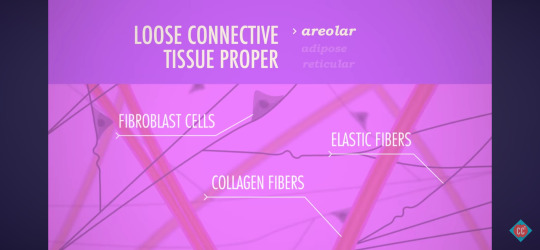
Areolar tissue is the most common loose connective tissue, found all of your body, just under the epithelial tissue, and wrapped around organs.
It has a loose and random arrangement of fibers, with a few fibroblast cells that make the fibers.
Latin term - "a small open space"
E.g. If you slam your shin on a coffee table and inflame the area, the areolar tissue soaks up extra fluids like a sponge, and resulting swelling and puffiness is called edema.
Areolar tissue is a kind of sponge for watery ground substance.
Adipose Tissue (Fat Tissue)
adipocytes
nucleus
lipid vacuole
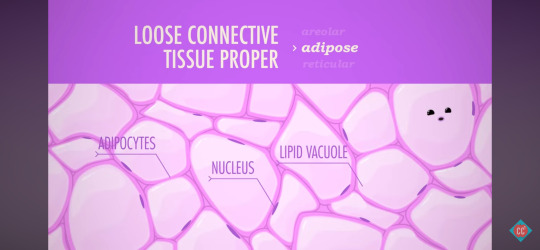
Adipose tissue is mostly cells, adipocytes, which store lipids for later use, insulate the body against heat loss and grow pot bellies/love handles.
The average person's weight is 18% adipose tissue.
Reticular Tissue
reticular fibers
developing blood cells
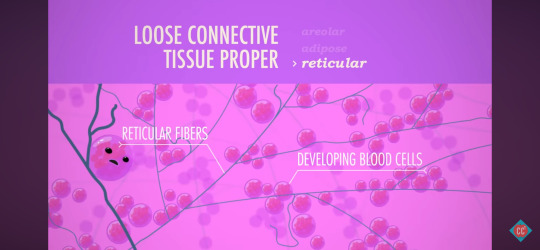
Reticular tissue is similar to areolar tissue, but with a woven mass of reticular fibers, instead of collagen and elastin fibers.
It provides the soft internal framework, or stroma, of the spleen, lymph nodes, and bone marrow, and supports lots of developing bloody cells.
While areolar tissue is a kind of sponge for watery ground substance, reticular tissue is what holds your blood in place in many of your organs.
Loose connective tissue proper types share an airy dispersal of fibers.
Types of Dense Tissue Proper: Regular, Irregular and Elastic
Dense Regular Tissue
fibroblast nucleus
collagen fibers
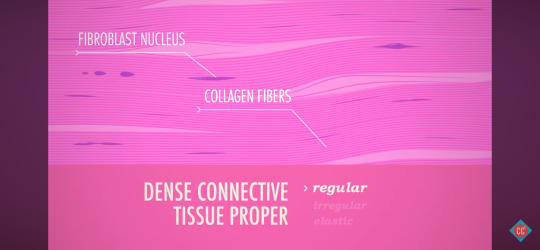
Dense regular tissue is full of tight bundles of collagen fibers all running parallel.
Found in tendons, muscle to bone, and ligaments, which bind bones together anywhere there's a joint
Dense Irregular Tissue
collagen fibers
fibroblasts
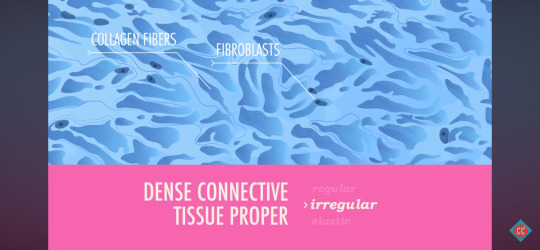
Dense irregular tissue, whose fibers are thicker and arranged erratically, are found wherever tension may be exerted in lots of different directions. E.g. the leathery dermis underlying skin
Dense Elastic Tissue
elastic fibers
stretchy, elastic tissue
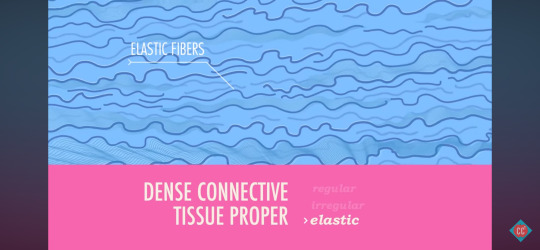
Found in vertebrae, so spine can curve and twist.
Found in large artery walls, provides support and flexibility.
Connective tissue proper is the most diverse group in this tissue family.
Types of Cartilage: Hyaline, Elastic and Fibro
Cartilage
Cartilage doesn't have any blood or nerves and stands up against both tension and compression pretty well.
Hyaline
chondrocytes
lacunae

Hyaline cartilage is the most common type.
glassing-looking, provides pliable support
It connects ribs to the sternum and keeps the tip of the nose perky.
Its ground substance is rich with sticky, starchy proteoglycans.
Although it has collagen fibers, you can't really see them under a microscope, instead the tissue looks glass.
"Hyal" = glassy, transparent.
Elastic Cartilage
chondrocytes
elastic fibers
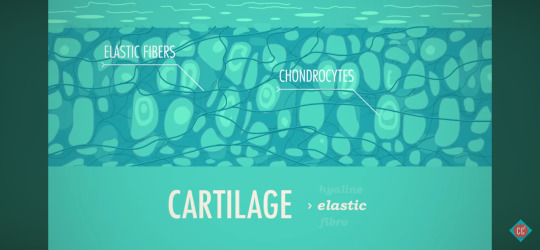
Elastic cartilage is similar to hyaline cartilage, but with more elastic fibers that are easier to see.
Found in places where strength and stretchability are needed.
Fibro Cartilage
chondrocyte
collagen fibers
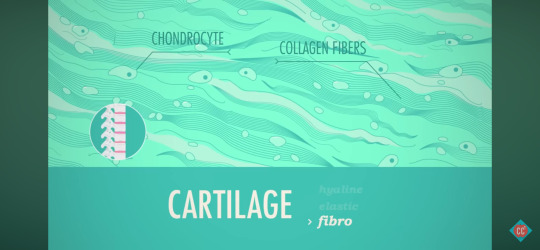
Fibro cartilage acts as a shock absorber. It's dominated by thick fibers of collagen and is good at withstanding pressure, so it makes up the discs between vertebrae, and knee joints where it keeps bones from grinding together.
Types of Osseous (Bone) Tissue: Spongy and Compact
Fun Fact: Each bone is considered a separate organ
"Bone" can refer to an entire organ, like femur or scapula, or just bone tissue.
Bone, or osseous tissue, is calcified connective tissue, perfect for supporting and layering the body's various structures.
Spongy Bone Tissue
Spongy bone tissue is typically found in the heads of long bones and in the inner layer of flat bones. E.g. sternum.
It's strong, but porous, even to the naked eye, and uses the extra room to make and store bone marrow.
Compact Bone Tissue
osteocyte (within lacuna)
Compact bone tissue is quite dense, with no visible spaces. It forms the external layer of the bones and stores calcium for bone cells to use to make more tissue
Blood is a Connective Tissue
connects distant parts of your body
provides rigidity to other parts
Blood develops from mesenchyme, is made up of cells surrounded by an extracellular nonliving matrix.
The ground substance is the blood plasma, which has protein fibers floating around it.
The blood's main job is delivery - transports cells, nutrients, hormones wastes etc., keeping all the parts of the body connected in the process.
Blood
Red Blood Cells
Erythrocytes
Zoom around, carrying oxygen and carbon dioxide through the body.
White Blood Cells
Leukocytes
larger
infection-fighting
Platelets
The small cell fragments needed for blood cutting.
Unlike other connective tissues, it doesn't have typical fibers, but instead has protein dissolved in the plasma, and the protein molecules form fiber-like structures when blood needs to clot.
0 notes
Text
Does Surgery Needed for Every Fracture?
In certain cases, treating a fracture requires surgery. The degree of the break, whether it is "open" or "closed," and the particular bone affected will determine the kind of fracture treatment needed. For instance, a broken hip or leg bone is handled differently than a broken vertebra, which is part of the spine.

The following surgeries are used to treat certain fractures: A break that usually happens in a bone is called a fracture. Most commonly, fractures result from falls, motorbike and automobile crashes, or even injuries sustained in sports. Because osteoporosis causes decreased bone density, fractures can potentially result from this condition. A bone can break entirely or partially in a variety of ways, including lengthwise, across, and in several pieces. Fixation from the outside Metal screws or pins are inserted into the fractured bone both above and below the fracture site during this procedure. The screws or pins are fastened to an external metal bar. This apparatus serves as a stabilizing frame to maintain the normal alignment of the bones during the healing process. If there is significant injury to the skin and other soft tissues surrounding the fracture, an external fixator may be used until the patient is able to withstand surgery. Internal Fixation and Open Reduction During this procedure, the broken pieces of bone are first reduced to their original place and then secured with metal plates or unique screws to the bone's exterior. Another way to keep the pieces together is to pierce the center of the bone with rods and implant them into the marrow area. You can notice when there is a fracture: - Extreme edema and pain - Skin that is bruised and discolored in the vicinity of the injury - Dislocation or abnormal bending at the fracture or joint location - Incapacity to use the injured leg for movement or to perform any daily tasks - If the fracture is open, bleeding from the fracture location
Which breaks need to be cast? Short arm casts, which are placed from the hand's knuckles to just below the elbow, are used for forearm and wrist breaks.
Long arm casts that extend from the upper arm to the hand's knuckles are used for fractures of the elbow or upper arm.
Short leg casts, which extend from just below the knee to the bottom of the foot, are used for breaks of the ankle and lower leg.
Long leg casts are used for breaks to the knee, lower leg, or ankle. They are placed from the upper thigh down over the foot. According to Dr. Ashok Kumar Sharma, the best course of action for administering first aid is to keep the injured area immobile and to seek medical assistance right away. A fracture can be avoided by using caution in one's daily activities. Consult with the best orthopaedic doctor in Noida for any fracture related issue.
0 notes
Text
#1 is from room 2/6: he's the only one.
she's Mrs. N with acute myeloid leukemia.
an expansion of immature "blast cells" in the peripheral blood and bone marrow resulting in ineffective erythropoiesis and bone marrow failure (Vakiti A, Mewawalla P., 2023).
the first time she came, she had a severe perpebral edema. the whole of her body was full with bruises behind the tattoos she made.
once you see her, you might think she used to be a very brave and strong independent woman before she was diagnosed with that terminal ill.
and she really was.
she raised a boy, an only child, all by herself.
a boy who also express a bravement, strength, and bit mischievous.
to be noted that they also lived near with a bus station on the edge of the town. they strongly have image as people with a though life.
if we refer to how people see this world generally, the woman might seem like a bad mother for what she did to her body and how she's been spending her life;
but look at what she made?
a boy, an only child who treat her very right. who never let her alone at the hospital, he didn't even go to school (cause he isn't adminitered to, I think).
he keep doing his best to treat her mother.
such a very angelic boy I ever met.
her ilness has a very poor prognosist.
but she never give up on it.
also her child.
they trust the doctors, they trust the nurses.
bu, tetep berjuang ya. ibu hebat udah menjalani kerasnya kehidupan sambil tetap membesarkan seorang anak seorang diri. sampai anak ibu jadi sebegitu sayangnya sama ibu.
dan, dik, makasih udah jagain ibu sebegitunya, udah rawat ibu siang-malam dan ngga pernah ngeluh, udah mau lakuin semua hal demi ibu. kamu anak baik. surga buat kamu, dik.
0 notes